#7th Armoured Division
Explore tagged Tumblr posts
Text

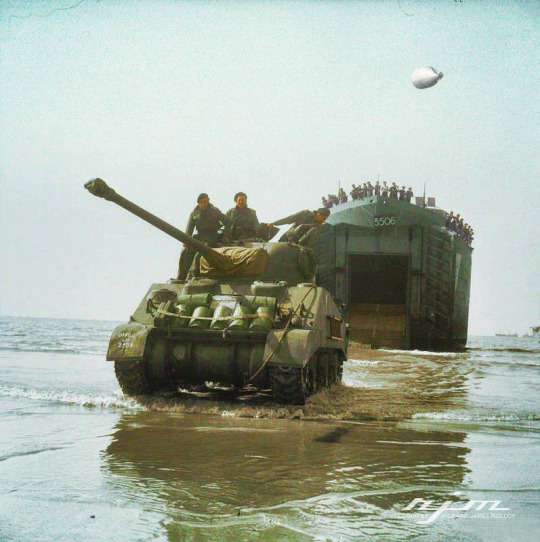
Un Sherman Firefly de la 22nd Armoured Brigade, 7th Armoured Division débarque d'un LST (Landing Ship Tank) sur Gold Beach – Opération Overlord – Calvados – Normandie – 7 juin 1944
Photographe : Sergent Laing - No. 5 Army Film and Photo Section, Army Film and Photographic Unit
©Imperial War Museums - B 5130
©Colorisation de RJM
#WWII#opération overlord#overlord#bataille de normandie#battle of normandy#7e division blindée GB#7th Armoured Division#22e brigade blindée GB#22nd Armoured Brigade#gold beach#calvados#normandie#normandy#france#07/06/1944#06/1944#1944
82 notes
·
View notes
Text
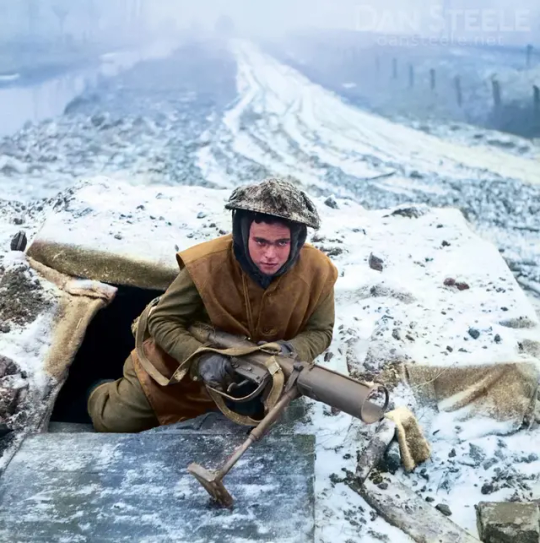
Rfn. Faulkner of London, emerges from his front-line dugout, armed with a PIAT. 1st Battalion Rifle Brigade, 7th Armoured Division, Nieuwstadt, Dutch-German border. 28 Dec 1944.
59 notes
·
View notes
Text

introducting...
CARMEN AND JONAH HARRY
Name: Carmen Harry Date of Birth: 8th March, 1916 Place of Birth: London, England Date of Enlistment: December, 1939 Unit: Security Intelligence Middle East (SIME), MI5 Status: UNKNOWN
━━━━━━━━━━━━━━
Name: Jonah Harry Date of Birth: 8th March, 1916 Place of Birth: London, England Date of Enlistment: February, 1940 Unit: 7th Armoured Division L Detachment, SAS Status: DECEASED
#merry christmas - new doomed siblings for your stocking <3#oc: carmen harry#oc: jonah harry#sas: rogue heroes#sas rogue heroes#sas:rh oc#sas rogue heroes oc#bill fraser x oc
24 notes
·
View notes
Photo

Desert Rats
The Desert Rats was the nickname of the 7th Armoured Division of the British Eighth Army, which first fought in North Africa during the Second World War (1939-45). Fighting in the Western Desert Campaigns and the North Africa Campaign, the Desert Rats, so called because of their jerboa shoulder flash, participated in such famous victories as the battles of El Alamein.
Origins & Name
The 7th Armoured Division sprang from the Mobile Division (Egypt), formed in 1938. The division was given excellent training by its commander Major-General Percy Hobart (1885-1957). Hobart had fought in Mesopotamia in the First World War (1914-18), gaining an impressive row of medals for bravery. In the inter-war years, he gained long experience as a tank commander. Hobart also served as a Director of Military Training. A quirky individual who struggled to get on with his peers, Hobart certainly knew what was required for the desert, and it is thanks to his vision that Britain had at least one fighting force that could match the elite of the Axis powers. Hobart's eccentricity and reputation as a flawed genius is revealed by his demise after falling out with the powers that be when the war started, his time spent in the military wilderness as a mere lance corporal in the Home Guard, and then his dramatic rise back to the forefront of generalship when he was given command of whole divisions again, including one of specialised vehicles he himself had developed, used with great success to clear the beaches in the D-Day Normandy landings of 1944.
In a still relatively new concept of mixed arms, Hobart ensured the Mobile Division combined infantry, artillery, and tanks, and it did what its name suggested, emphasising the necessity of movement in modern mechanised warfare. One of Britain's best commanders, Major-General Richard O'Connor (1889-1981), noted in 1939 that the Mobile Division was "the best-trained division I have ever seen" (Liddell Hart, 93).
The Mobile Division earned its 'Desert Rats' nickname from the badge (shoulder flash) its members wore, which showed a jerboa, a small rodent with a long tail, native to the North African desert. Due to the fact that all British and British Empire troops were fighting the same enemy in the same way in the same environment, the name 'Desert Rats' is often applied to any British/British Empire soldier involved in the Desert War in WWII. The extension of the term 'rats' is also evidenced in the nickname 'the Rats of Tobruk' for those Allied soldiers who held out during the siege of Tobruk from April to December 1941.
Desert Rats Shoulder Flash
Unknown Artist (Public Domain)
Continue reading...
24 notes
·
View notes
Text

Christmas at the frontlines in Groesbeek 1944
The Netherlands
Picture: PIAT gunner of 1st Battalion Rifle Brigade British 7th Armoured Division, December 1944.
6 notes
·
View notes
Text
A Short Timeline of the Events of 422-3
(Somewhat of a companion piece to Wei-Song Wars Part 1)
guihai day of the fifth month (June 26th 422): Liu Yu dies. Liu Yifu, aged 16, inherits the throne.
An unknown time between the fifth month and ninth month: Tuoba Si heard of Liu Yu's death and plans an invasion of Liu-Song.
At some point before troops are sent out: After a long debate, although Tuoba Si agreed with Cui Hao that the countryside should be attacked first, on the insistence of Gongsun Biao and Daxi Jin he uses the strategy of attacking the three cities first.
Ninth month: Daxi Jin, Gongsun Biao and the others lead 20,000 troops to attack Huatai, but are unable to take it.
dingchou day of the tenth month (November 7th): Northern Wei launches an attack on Chenliu, and the governor Yan Leng surrenders.
renchen day of the tenth month (November 22nd): Daxi Jin and the others ask for reinforcements. Tuoba Si, angry, rebukes Daxi Jin and Gongsun Biao for insisting on attacking cities and gathers 50,000 troops from his vassals, which he leads to aid them as reserve troops.
Eleventh month: Tuoba Dao is sent to guard against Rouran, leaving the minister An Tong and another son of Tuoba Si's, Tuoba Mi, to guard the capital.
gengxu day of the eleventh month (December 10th): Northern Wei forces take Huatai. Wang Jingdu flees, while Ruogan Er is appointed to guard the city.
Shortly after: Daxi Jin and the others take Tulou garrison, and move to threaten Hulao, while Wuniuyu Lidi leads 3,000 to threaten Luoyang.
bingxu day of the twelfth month: Tuoba Si sends Yizhan Jian with a force to attack Qing and Yan provinces.
Twelfth month: Wuniuyu Lidi and Daxi Jin attack Dou Huang together and defeat him. Tuoba Si sends E Qing, Yujiulu Dafei and Pu Ji to take Que'ao.
guiwei day of the twelfth month (January 12th of 423): The Song governor of Yan province, Xu Yan, abandons the province, allowing Yizhan Jian to enter Qing provinces.
wuzi day of the twelfth month (January 17th): Northern Wei threatens Hulao.
jichou day of the twelfth month (January 18th): Liu Yifu sends Tan Daoji to relieve the threatened provinces.
guimao day of the first month of the first year of Jingping (February 1st): Wuniuyu Lidi takes Jinyong fortress and takes him; Tuoba Si appoints him to remained stationed.
First month: Yizhan Jian enters Qing provinces, taking many of the surrounding cities, but Zhu Kui orders that Dongyang be bolstered as a defense center and outside grain be burned.
Third month: Daxi Jin and the others assault Hulao with 15,000 troopsl. Mao Dezu digs tunnels to burn Northern Wei siege equipment; but despite killing hundreds of troops, the Northern Wei army quickly resume their siege.
Tuoba Si sends troops from Ye to help attack Hulao. Daxi Jin leads 3,000 troops out of Hulao, while leaving Gongsun Biao and the rest of the troops to attack Xuchang, and Li Yuande flees. He seizes Henan commandery, Yingchuan commandery and Chen commandery before returning to Hulao.
Gongsun Biao fought a fierce battle at Hulao, and at first Mao Dezu killed hundreds of Wei troops. But when Daxi Jin returned from seizing nearby land, he attacked Mao Dezu and defeated him; Mao Dezu lost more than a thousand armoured men, and he stopped venturing out of Hulao, keeping resistance from inside the city.
Tuoba Si sent 10,000 troops to cross the Yellow River to camp at Puyang and strengthen his hold on Yan province.
Mao Dezu frames Gongsun Biao as a collaborator; Daxi Jin falls for the trap and tells Tuoba Si. Eventually, a petition is sent blaming Gongsun Biao for the length of the siege. As well, Tuoba Si was frustrated with Gongsun Biao's military mistakes, so due to all of this, he sent someone to kill Gongsun Biao, but since he did not announce Gongsun Biao's death, Mao Dezu's ploy failed to cause division in the Wei army.
Tan Daoji, seeing that he was closer to Qing province and they were in more need of aid, saves Qing province, essentially abandoning Si province due to his lack of troops.
Third month: Tuoba Si sends 50,000 cavalry to relieve Yizhan Jian; when the Wei army attacked Qing province, in total 60,000 Wei cavalry crossed the Yellow River from beginning to end (the Zizhi Tongjian's placement of Tuoba Si's sending of Diao Yong must be incorrect; it was in the late second or early third month, not in the first month)
jiazi day of the third month (April 23rd): Li Yuande launches a surprise attack on Xuchang and recaptures it (The Weishu dates this to the ninth month instead).
E Qing, Pu Ji and Yujiulu Dafei seize the rest of Yan province, reaching Gaoping and Hulu, where, after the civilians shoot at them with arrows, they massacre the men of more than two thousand families and take as captives the women and children.
Tuoba Si sends the governor of Bing province, Yilou Ba, to help assault Hulao. While Mao Dezu killed many Wei troops, he was losing many of his own soldiers as well.
dingmao day of the fourth month (April 26th): Tuoba Si leads a reinforcement army into Hulao. After cutting off water from the Yellow River to Hulao, he waited for three days before personally supervising an assault. However, the city still did not submit, so he left Hulao for Luoyang.
jisi day of the fourth month (April 28th): Tan Daoji arrives at Linzi.
renshen day of the fourth month (May 1st): Since Tan Daoji arrived and a plague had spread through the army at Qing province, Yizhan Jian burns his siege equipment and retreats.
Tan Daoji camps his troops at Hulu, and Wang Zhongde soon joins him. Diao Yong gathers refugee families at Yinmao. Yizhan Jian joins the fight at Hulao, but this also spreads the plague his troops encountered to the troops at Hulao.
dingsi day of the intercalary month (June 15th): Northern Wei blocks access to Hulao's wells.
jiwei day of the intercalary month (June 17th): Hulao falls. Mao Dezu and his officers are almost all captured.
Fifth month: Tuoba Si returns to Pingcheng.
Ninth month: Tuoba Si calls Daxi Jin back from Hulao, leaving troops to guard the south.
Eleventh month: Pu Ji attacks Xuchang, which falls.
wuchen day of the eleventh month (December 23rd): Northern Wei takes Ruyang commandery. Pu Ji destroys Xuchang's walls and Zhongcheng city before returning to garrison Fangtou.
jisi day of the eleventh month (December 24th): Tuoba Si dies.
3 notes
·
View notes
Photo
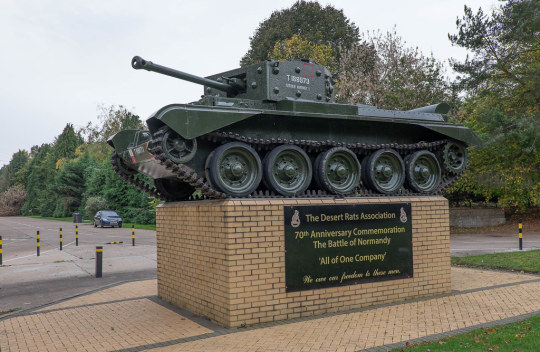
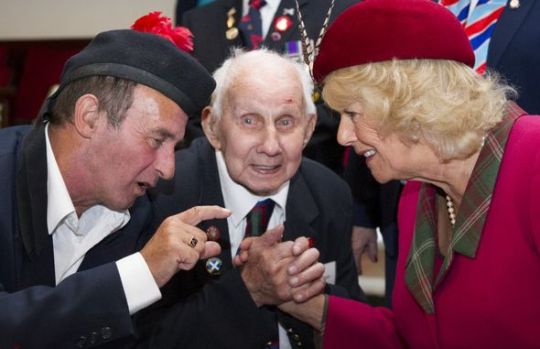
Queen Camilla’s Patronages
The Desert Rats Association (Patron from 27.07.2007)
The 7th Armoured Division was a British armoured division which saw service during the Second World War where its exploits made it famous as the Desert Rats.
After the Munich Crisis, the division was formed in Egypt during 1938 as the Mobile Division (Egypt) and its first divisional commander was the acclaimed tank theorist Major-General Sir Percy Hobart. During January 1940, the name of the unit was changed to the 7th Armoured Division. It was during this period that the nickname “Desert Rats” was coined. The division fought in every major battle during the North African Campaign; later it would land and fight in Italy before being withdrawn to the United Kingdom where it prepared to fight in North West Europe. It began landing in Normandy during the afternoon of 6 June and fought its way across Europe ending the war in Kiel and Hamburg, Germany. The 7th Armoured Brigade was detached from the division during early 1942 and fought the Japanese during the fighting in Burma before it returned to the Mediterranean Theatre and fought in Italy.
“As the proud daughter of a 12th Lancer, Major Bruce Shand, who fought with the regiment in France and North Africa alongside the Desert Rats and was awarded the Military Cross in both campaigns, I grew up with the history and traditions of the 12th and subsequently the 9th/12th Lancers and have always felt a deep affinity to the regiment, which is hardly surprising as you are, after all, the ‘Prince of Wales’s own’. I know that wherever my (papa) is tonight he will be drinking a toast to the 9th/12th Royal Lancers, a regiment in which he was so proud to have served. I feel very proud of my connection to this regimental family, and it is with enormous pride that I put on my 9/12th Lancers brooch, which I intend to wear for many years to come.” - Queen Camilla
34 notes
·
View notes
Text
18 June 2023
Boney Was A Warrior
Aspley House 18 June 2023
It is now 208 years since the Battle of Waterloo. It was here, on perhaps the most famous battlefield in history, that the forces of the Duke of Wellington’s Anglo-Allied Army and Field Marshal Gebhard von Blucher’s Prussian Army decisively defeated Napoleon, ending over two decades of near constant European War and establishing a political order that would persist mostly unbroken for thirty years. In 2015, there was great pomp and ceremony at the site to mark its bicentennial. I was there. (At the bicentennial, not the battle.) So was the then Prince of Wales, and for reasons I’ve never completely worked out, Nigel Farage.
I couldn’t make the trip to Mont St Jean (for the battle was fought a few miles away from Waterloo itself), but I was going into London today, and it seemed appropriate to drop in to Aspley House, the Duke’s London residence, to mark the occasion.
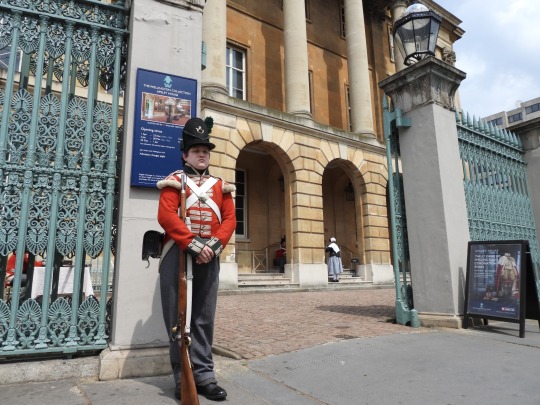
Aspley House - ‘No. 1, London’ - is as handsome a Georgian townhouse as ever there was, and with the exception of containing perhaps more paintings than it did in his time, is kept pretty much as Wellington knew it. It is absolutely worth a visit. Yet I must make one major criticism of how Aspley House is run, and that is that it has a blanket ban on interior photography. I simply cannot agree with this. No flash photography is completely understandable, but I can’t help but feel that prohibiting photography altogether is a step too far, and out of touch with the modern world of phone cameras and go-pros. I do understand the reason - copyright - I just think it’s a poor reason.
Of course, you can take photos of the exterior to your heart’s content, and as an English Heritage property, there’s often little events going on to attract interest. Today, being Waterloo Day, the front of the house was occupied by redcoats - the men of the 68th Foot, the Durham Light Infantry. Of all the regiments of the British Army (or at least those I don’t have a family connection to), I’ve always had a particularly soft spot for the DLI. The 6th, 7th and 9th Battalions, during WWII, were formed into one brigade for most of the war in Europe, and Montgomery regarded them quite highly. (The 6th and 7th were rotated home at the end of 1944 for a well-earned rest, but the 9th DLI was folded into the famed 7th Armoured Division and fought for the last few months of the war.) On top of this, they had green facings, and my favourite colour is green, so that works well.
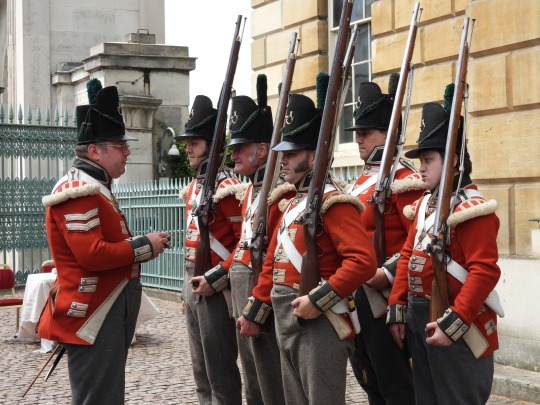
The reenactors drilled before visitors at 1pm, giving their audience a good idea of how British soldiers drilled, what they wore and how they fought in the Napoleonic Wars - specifically in the Peninsular and Waterloo campaigns and the War of 1812 against America. It was a very good show, and I quite enjoyed it. Kudos to the 68th!
(In case one is wondering what other British regiments I have a ‘soft spot’ for, they would be those my family were part of - the descendents of the 60th and 95th Rifles, plus the Royal Engineers and the Royal Artillery - the 2nd (Coldstream) Foot Guards, the Royal Marines, the Middlesex, the Black Watch, the Ox and Bucks and the Argyll and Sutherland Highlanders. I’ll stop myself there because I kept thinking of others.)
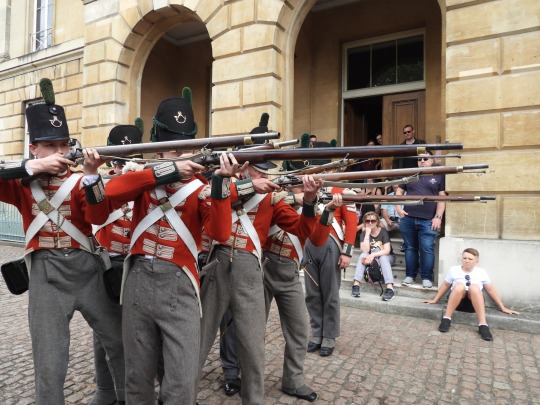
After Aspley House, we headed back down the Victoria and Northern Lines to Edgware, which will be my home base for tonight. Tomorrow will be a long day - the longest day, I’d say, except that refers to the wrong war - ambling around Central London looking at war memorials, the great monuments of the Imperial Metropolis, and a little provincial church they call Westminster…
#napoleonic wars#aspley house#duke of wellington#british army#68th foot#durham light infantry#redcoats#historical reenactment#battle of waterloo
13 notes
·
View notes
Text

White-washed Cromwell tanks of 7th Armoured Division, 16 January 1945.
0 notes
Text
Assad releases his first statement since fleeing Syria
The departure of ousted Syrian President Bashar al-Assad from the country was unplanned, according to a statement released Monday by the Syrian presidency’s Telegram account and purportedly coming from Assad.
The statement from the Syrian Presidency account on Telegram said:
“My departure from Syria was neither planned nor did it occur during the final hours of the battles, as some have claimed. On the contrary, I remained in Damascus, carrying out my duties until the early hours of Sunday December 8th 2024.”
When Assad arrived at the Latakia base, he said “it was clear that our forces had been completely withdrawn from all fighting positions and that the last positions of the army had fallen and the situation continued to deteriorate.” The former Syrian president stressed that Moscow then offered to organise an immediate evacuation to Russia. He also added:
This happened the day after the fall of Damascus, after the fall of the last military positions and the consequent paralysis of all remaining state institutions.
The former president added that during these events he “never once thought of resigning or seeking asylum.”
Assad emphasised in the statement that during the rebel offensive,”‘terrorism spread throughout Syria and eventually reached Damascus on the evening of Saturday the 7th.”
This was followed by “questions about the fate and whereabouts of the president,” which came “amid a flood of disinformation and stories that are far from the truth.”
The president’s statement should have been published even earlier, he added. But “the circumstances prevailing at the time, including a complete shutdown of communications for security reasons, led to a delay in the publication of this statement. Moscow and the date of December 16 are listed there as the place of publication of the statement.
The statement also said:
“When the state falls into the hands of terrorism and the ability to make a meaningful contribution is lost, any position becomes void of purpose, rendering its occupation meaningless.”
Bashar al-Assad’s escape from the country was organised with the help of Russian intelligence officers, Bloomberg quoted sources as saying. They took him out via a Russian airbase in Syria.
During Assad’s departure, the transponder of the aircraft was switched off so that it would not be tracked. At the same time, before leaving, Russia convinced the former Syrian president that he would lose the fight against armed rebels, the agency claimed.
Syria’s central bank under Bashar al-Assad ‘s presidency sent several planes to Moscow with millions of dollars and euros in cash, Financial Times previously reported, citing confidential documents.
Assad kept his plans to leave the country secret and before his escape allegedly assured officers that Russia would help, Reuters reported earlier, citing sources.
“Hours before his escape to Moscow, Assad assured at a meeting with about 30 army and security chiefs at the defence ministry on Saturday that Russian military support was on the way and urged ground forces to hold on,” the agency quoted the interlocutors as saying.
The authors of the materials also stress that Assad hid his plans to flee for so long that he did not even inform his younger brother Maher Assad, the commander of the elite 4th Armoured Division.
Read more HERE

#world news#news#world politics#middle east#syria#syria news#syria civil war#syria crisis#syria conflict#syria coup#assad regime#aleppo#damascus#syrian civil war#syrian rebels#bashar al assad#assad
1 note
·
View note
Text
Unboxing: Typhoons,Stuarts and M10s
I read on Battlefront's Flames of War website about the perfect additions to my 7th armoured division army, it would take the army upto 100pts, this I am reliably informed is the standard size game for Flames of War. The sets were very hard to come by, I had to get them from third party retailers and Amazon. I bought the following sets:
Typhoon Fighter Flight
M10 SP Anti-tank Platoon
Stuart Recce Patrol
First up is the Typhoon Fighter Flight, It is a resin kit, which surprised me. The instructions on how to build it are on the reverse of the box. The set was well packaged and secure. The kit contains:
2x Typhoon Aircraft
1x Decal Sheet
2x Flight Stands
4x Rare Earth Magnets
1x Unit Card




Next up we have M10 SP Anti-tank platoon. Once again the set was secure. The instructions are also on the rear of the box. This time the kit was in plastic. The set contained the following:
4x M10 Tank Destroyers
1x Decal Sheet
1x Unit Card



Finally we have the Stuart Recce Patrol, like both the previous kits the sprues were very secure. Instructions on the rear of the box which in my limited experience with Battlefront kits, seems to be the norm. The kit is another plastic kit and has the following components:
4x Stuart (37mm) Tanks
1x Decal Sheet
2x Unit Cards



All in all another three superb looking kits that I cannot wait to build and paint. I really need to stop buying stuff and get some of these models onto the tabletop.
That is all for now,
until next time
Happy Hobbying!
0 notes
Photo

Les chars Cromwell de la 7e Division blindée britannique se préparent à attaquer Caen par la rive Est de l'Orne – Bataille de Caen – Opération Goddwood – Bataille de Normandie – Calvados – Normandie – France – 18 juillet 1944
Photographe : Sergent Laing - No. 5 Army Film and Photo Section, Army Film and Photographic Unit
©Imperial War Museums - B 7649
#WWII#Opération Overlord#Overlord#Bataille de Normandie#Battle of Normandy#Bataille de Caen#Battle of Caen#Opération Goodwood#Goodwood Operation#Armée britannique#British Army#7e Division blindée britannique#7th Armoured Division#Char#Tanks#Char de cavalerie#Cruiser tank#Char Cromwell#Cromwell tank#Calvados#Normandie#Normandy#France#18/07/1944#07/1944#1944
39 notes
·
View notes
Text

US soldiers of the 10th Armoured and 45th Division, 7th US Army stand on a captured German 274mm railway hun in Rentwertshausen, Germany. April 1945.
64 notes
·
View notes
Text
Events 6.13 (before 1950)
313 – The decisions of the Edict of Milan, signed by Constantine the Great and co-emperor Valerius Licinius, granting religious freedom throughout the Roman Empire, are published in Nicomedia. 1325 – Ibn Battuta begins his travels, leaving his home in Tangiers to travel to Mecca (gone 24 years). 1381 – In England, the Peasants' Revolt, led by Wat Tyler, comes to a head, as rebels set fire to the Savoy Palace. 1514 – Henry Grace à Dieu, at over 1,000 tons the largest warship in the world at this time, built at the new Woolwich Dockyard in England, is dedicated. 1525 – Martin Luther marries Katharina von Bora, against the celibacy rule decreed by the Roman Catholic Church for priests and nuns. 1625 – King Charles I of England marries Catholic princess Henrietta Maria of France and Navarre, at Canterbury. 1740 – Georgia provincial governor James Oglethorpe begins an unsuccessful attempt to take Spanish Florida during the Siege of St. Augustine. 1774 – Rhode Island becomes the first of Britain's North American colonies to ban the importation of slaves. 1777 – American Revolutionary War: Gilbert du Motier, Marquis de Lafayette lands near Charleston, South Carolina, in order to help the Continental Congress to train its army. 1805 – Lewis and Clark Expedition: Scouting ahead of the expedition, Meriwether Lewis and four companions sight the Great Falls of the Missouri River. 1850 – The American League of Colored Laborers, the first African American labor union in the United States, is established in New York City. 1855 – Twentieth opera of Giuseppe Verdi, Les vêpres siciliennes ("The Sicilian Vespers"), is premiered in Paris. 1881 – The USS Jeannette is crushed in an Arctic Ocean ice pack. 1886 – A fire devastates much of Vancouver, British Columbia. 1893 – Grover Cleveland notices a rough spot in his mouth and on July 1 undergoes secret, successful surgery to remove a large, cancerous portion of his jaw; the operation was not revealed to the public until 1917, nine years after the president's death. 1895 – Émile Levassor wins the world's first real automobile race. Levassor completed the 732-mile course, from Paris to Bordeaux and back, in just under 49 hours, at a then-impressive speed of about fifteen miles per hour (24 km/h). 1898 – Yukon Territory is formed, with Dawson chosen as its capital. 1917 – World War I: The deadliest German air raid on London of the war is carried out by Gotha G.IV bombers and results in 162 deaths, including 46 children, and 432 injuries. 1927 – Aviator Charles Lindbergh receives a ticker tape parade up 5th Avenue in New York City. 1944 – World War II: The Battle of Villers-Bocage: German tank ace Michael Wittmann ambushes elements of the British 7th Armoured Division, destroying up to fourteen tanks, fifteen personnel carriers and two anti-tank guns in a Tiger I tank. 1944 – World War II: German combat elements, reinforced by the 17th SS Panzergrenadier Division, launch a counterattack on American forces near Carentan. 1944 – World War II: Germany launches the first V1 Flying Bomb attack on England. Only four of the eleven bombs strike their targets.
0 notes
Photo

Dunkirk Evacuation
The Dunkirk Evacuation of 26 May to 4 June 1940, known as Operation Dynamo, was the attempt to save the British Expeditionary Force in France from total defeat by an advancing German army. Nearly 1,000 naval and civilian craft of all kinds, aided by calm weather and RAF air support, managed to evacuate around 340,000 British, French, and Allied soldiers.
The evacuation led to soured Franco-Anglo relations as the French considered Dunkirk a betrayal, but the alternative was very likely the capture of the entire British Expeditionary Force on the Continent. France surrendered shortly after Dunkirk, but the withdrawal allowed Britain and its empire to harbour its resources and fight on alone in what would become an ever-expanding theatre of war.
Germany's Blitzkrieg
At the outbreak of the Second World War when Germany invaded Poland on 1 September 1939, France was relying almost entirely on a single defensive line to protect itself against invasion. These defences were the Maginot Line, a series of mightily impressive concrete structures, bunkers, and underground tunnels which ran along France's eastern frontiers. Manned by 400,000 soldiers, the defence system was named after the French minister of war André Maginot. The French imagined a German attack was most likely to come in two places: the Metz and Lauter regions. As it turned out, Germany attacked France through the Ardennes and Sedan on the Belgian border, circumventing most of the Maginot Line and overrunning the inadequate French defences around the River Meuse, inadequate because the French had considered the terrain in this forested area unsuitable for tanks. Later in the campaign, the Maginot Line was breached near Colmar and Saarbrücken.
To bolster the defences of France, Britain had sent across the British Expeditionary Force (BEF) under the command of General John Vereker (better known by his later title Lord Gort, 1886-1946). Around 150,000 men, mostly infantry, had arrived in September 1939 to strengthen the Franco-Belgian border. The BEF included the British Advanced Air Striking Force of 12 RAF squadrons. The aircraft were mostly Hawker Hurricane fighters and a few light bombers, all given much to the regret of RAF commanders who would have preferred to have kept these planes for home defence. The superior Supermarine Spitfire fighters were kept safely in Britain until the very last stages of the battle in France. The BEF had no armoured divisions and so was very much a defensive force, rather than an offensive one. More infantry divisions arrived up to April 1940, so the BEF grew to almost 400,000 men, but 150,000 of these had little or no military training. As General Bernard Montgomery (1887-1976) noted, the BEF was "totally unfit to fight a first class war on the Continent" (Dear, 130). In this respect, both Britain and France were very much stuck in the defensive-thinking mode that had won them the First World War (1914-18). Their enemy was exactly the opposite and had planned meticulously for what it called Fall Gelb (Operation Yellow), the German offensive in the west.
Totally unprepared for a war of movement, the defensive-thinking French were overwhelmed in the middle weeks of May 1940 by the German Blitzkrieg ("lightning war") tactics of fast-moving tanks supported by specialist bombers and smartly followed by the infantry. German forces swept through the three neutral countries of the Netherlands, Luxembourg, and Belgium. The 9th Army punched through the Ardennes and raced in a giant curve through northeast France to reach the coast around Boulogne. The BEF and the northern French armies (7th and 1st) were cut off from the rest of the French forces to the south. Germany had achieved what it called the 'Sickle Slice' (Sichelschnitt). By 24 May, the French and British troops were isolated and with their backs to the English Channel, occupying territory from Dunkirk to Lille. Although there were sporadic counterpunches by the defenders, Gort had already concluded that the French army had collapsed as an operational force. Gort considered an attack on the Germans to the south, which he was ordered to make, would have achieved very little except the annihilation of his army. The BEF must be saved, and so he withdrew to the north.
Continue reading...
28 notes
·
View notes
Text



Battledress Blouse of the 11th Hussars (Prince Albert's Own) from the British Empire dated to the 1940s on display at Horsepower, The Museum of the King's Royal Hussars in Winchester, England
This uniform was purchsed privately and worn by Captain Moore whilst serving with the 11th Hussars as part of the 7th Armoured Division during the Second World War. The yellow backing to the captain's rank badges and the red and yellow "flash" on the sleeves are unique to units of the Royal Armoured Corps.
The 11th Hussars became the first British cavalry regiment to be fully mechanised with the adoption of armoured cars in 1928 and were deployed in putting down the Arab revolt. During the Second World War they heavily involved in the North African campaign before taking part in the Allied Invasion of Italy.
Photographs taken by myself 2023
#fashion#uniform#second world war#cavalry#british empire#england#english#military history#20th century#horsepower museum#winchester#barbucomedie
1 note
·
View note